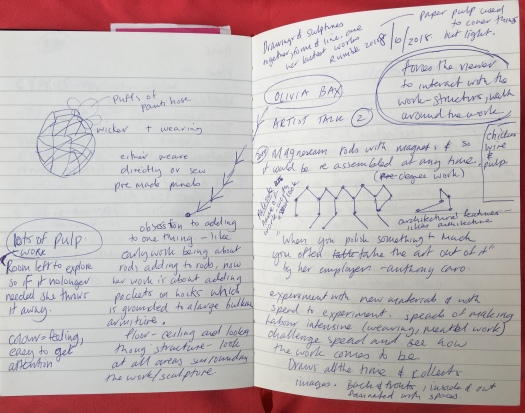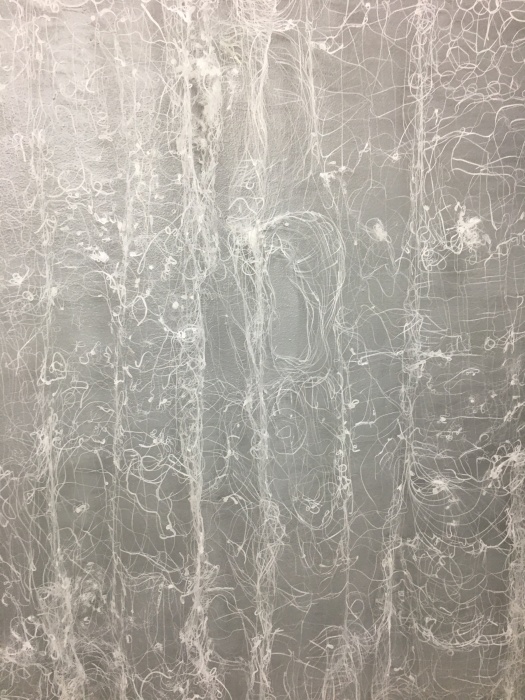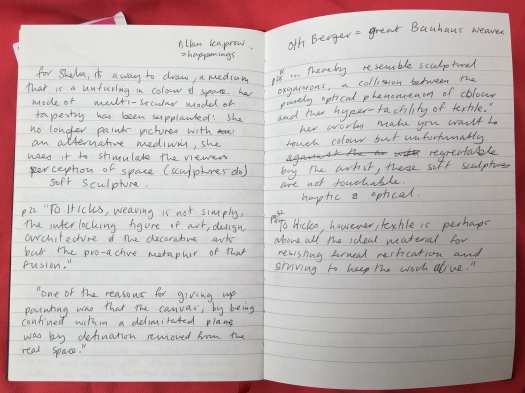
December Essay Notes (Not for assessment)
The necessities of distinctions between the Fine Arts and Contemporary Craft.
What is a distinction? Why are they necessary? Why do we need to define art practices, subjectively clarifying them within a cultural hierarchy ? This essay will explore these questions by referring to Contemporary Artists such as Judy Chicago, Grayson Perry, Shelia Hicks and Cat Mazz.
The distinction of contemporary craft has historically established itself as being a discipline of skills that are regarded to be traditional, hand made and produces something functional (. ) . The social implications of these skills tie in with feminism theories where Roziska Parker describes stitching as having “a heritage in women’s hands, and thus…more appropriate than male associated paint for making feminist statements.” (p37 Entangled ) . This essay will weave in theories by Jacques Lacan signifying the ‘castration’ or ‘lack’ where the identity of women are within a symbolic order, in art and everyday therefore connecting the distinctions that cause inequalities.
The theme of this essay will stitch together theories surrounding feminism associated with domesticated Craft and to what extent and in what ways has this association had in the role of contemporary crafts identity. Nevertheless the identity of Craft, particularly textiles is a productive discipline that is successfully able to cross boundaries and be heterogeneous.
“Craft is a contested concept, a word with almost too many associations” (Harrod, 2018:12)
Contemporary Art is a progressive art practice where Artists have broadened their use of mediums and collaborate skills such as Grayson Perry with his ceramic vases and tapestries. His classic Grecian styled urns are glazed with modern day dilemmas, or dark Gothic tales; ‘We’ve found the body of your child’ (2000. Earthenware ) The use of pottery to communicate and create an emotional response is an example of crossing the boundaries between Craft and Art.
This essay will evaluate the need to understand the different artistic disciplines and explain the consequences of cultural equality towards contemporary art practices. This insistence of questioning distinctions and societies inability to treat different disciplines equal, is a subject that is widely written about. Walter Benjamin wrote ‘The Work of the Art in the Age of Mechanical Reproduction’ in 1936, he refers to technologies mass reproduction capabilities of printing and argues that the ‘aura’ of the original is lost to reproducibility, however this opens up progressive possibilities. (Harrison &Wood, 2003:521)
The ecology of the human mind has the inclination to respect Walter Gropius definition of an Art-Craft unity (1920) and Patrick Heron’s article ‘Murder of Art Schools’ (1971) also proposes unity between Fine and Applied Arts.
Firstly I will cast on and start by explaining that, the word distinction in this essay is to be referred to as a definition that is recognising or is a noting of differences; discrimination. (dictionary.com. cited 21.12.18) The questioning of the; relevance to note a difference, is for the reason to understand the Artistic body of work more knowledgeably. The final question this essay asks is that when acknowledging distinctions, often a conscious line is drawn and decisions are made. Discrimination can be part of the process of deciphering the differences depending upon the discerning consciousness and their ideology informed from their social construct.
https://www.brooklynmuseum.org/eascfa/dinner_party/acknowledgement_panels/panel
Panel one of 3 acknowledging the contributors.
Chicagos feminist sociopolitical perspective has corollated the status given to women art and craft work with in walls of the institution. Around the same time Robert Smithson was expanding the fields of the Gallery walls with his rejection to them. His work was best known as Land Art, Earth Art or Earthworks such as ‘Spiral Jetty’ (1970). These creations are described by Ian Chilvers (4th 2009) as being a desire to sidestep the gallery systems that are considered elitist and money-orientated. This shift during a time of Conceptual art where projects such as ‘Happenings’ and ‘performance art’ were schemes and not expected to be permanent correlated with Land Art sculptures such as; ‘Spiral Jetty’ the work has become submerged and hypocritically can only be seen from the air. The Hypocrisy with these Art works was they were meant to be autonomous with our natural environment but were opposites due to the cost and diffulcultness for people to see them, therefore being exposed to elitist spectatorship and the massive construction associated with the work was a considerably violation towards the environment.
The ‘spectacularization’ of art (Foster. 2004:656) confirms Chilvers by explaining that Arichticture that is being developed to house post war art is able to Create a spectacular building such as the Guggenheim Museum (1991-7) in Bilbao and the Tate Modern (1995-2000) with the Blavatnik extension (2011-2016). These buildings have become tourist attractions often build in areas of previous industrial sites that have been redeveloped, once deprived areas rejuvenated. These homes for art works inflate the culture of art and Foster links this with the theories by the founder of the situationist international; Guy Debon and his essay ‘The society of the spectacle (1967). The Debordian theory of the spectacle as capital where capital accumulate to such a degree that it becomes an image, that image being the Galley and its brand identity, its a corporation fuelling a hierarchal level of spectatorship and hence speculation. These are both relevant to the understanding of divisions within the fields of Art. Judy Chicago wanted to give her work context and proclaim it as Fine Art and by placing it within the site of an institution of culture she was able to define it as a mixed media installation.
The Context given to the work by Smithson and Chicago are reliant upon the status of the site where the work is seen.
Link in post modern principles and the essay by Walter Benjamin with reference to contemporary crisis in art.
Link in laconian theories around desire and the constant need for more.
The relationship betweenEntropy and mimicry. Mention osmoses; might need to develop this idea in dissertation.
























































